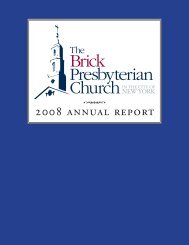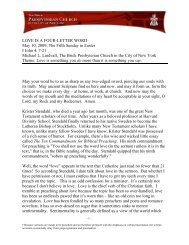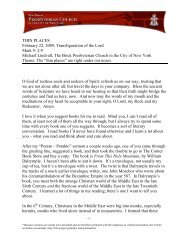SIC TRANSIT GLORIA MUNDI November 18, 2007 ... - Brick Church
SIC TRANSIT GLORIA MUNDI November 18, 2007 ... - Brick Church
SIC TRANSIT GLORIA MUNDI November 18, 2007 ... - Brick Church
You also want an ePaper? Increase the reach of your titles
YUMPU automatically turns print PDFs into web optimized ePapers that Google loves.
History of the World, Part I.” In that film, Brooks has a Roman Senator speak a<br />
shortened version of the phrase during the Roman Empire segment of the film.<br />
“Sic transit gloria,” one Roman Senator says to the other Roman Senator, in Latin.<br />
To which the second replies, in English, “I didn’t even know Gloria was sick.”<br />
The 21st Chapter of Luke’s Gospel finds Jesus and his disciples in Jerusalem<br />
during the week between Palm Sunday and Good Friday. Each day, Jesus goes to<br />
the courtyard in front of the magnificent Temple built atop the highest hill in<br />
Jerusalem. Nefarious King Herod had begun this particular Jewish temple almost<br />
50 years earlier; it was still probably not quite completed. In the first six verses of<br />
this 21st Chapter of Luke, two things happen. First, Jesus and his followers watch<br />
people making contributions to the temple by dropping coins in one of 13<br />
containers shaped like inverted trumpets installed for that purpose. Several<br />
wealthy people make generous donations; a poor widow makes a modest, but for<br />
her, extraordinarily generous, donation. In the second part of the reading, the<br />
disciples turn their attention from these contributors to the temple itself. They<br />
comment about how very lovely the building is, “adorned with beautiful stones and<br />
gifts dedicated to God.” To which Jesus replies, “… the days will come when not<br />
one stone will be left upon another; all will be thrown down.” “Sic transit gloria<br />
mundi,” as it were.<br />
About forty years after Jesus’ death and resurrection, the Roman general Titus,<br />
soon to be Emperor, laid siege to Jerusalem. The city had been held by Jewish<br />
rebels for the last four years. In August of 70 A. D., the city fell to the Roman<br />
legions. The great temple was utterly destroyed. Only one massive retaining wall<br />
on the western foot of the temple mount remained. That wall, the Western or<br />
“Wailing Wall,” is all there is today.<br />
There are two theories as to why the temple was leveled. One says that it was a<br />
deliberate strategy. Titus wanted to humiliate the Jews and stamp out the Jewish<br />
and Christian religions associated with the temple. Remember that in the First<br />
Century, Christians were still seen as a particular kind of Jew. The other theory<br />
says that burning the temple was a mistake. Titus’ troops just got out of hand.<br />
Either way, one glaring fact is obvious: These ages later the temple is still in ruins,<br />
but Judaism and Christianity thrive.<br />
- 2 -<br />
* Because sermons are meant to be preached and are therefore prepared with the emphasis on verbal presentation, the written<br />
accounts occasionally stray from proper grammar and punctuation.






